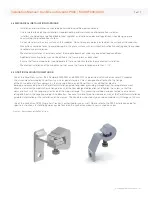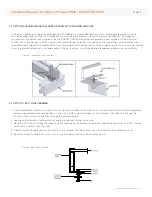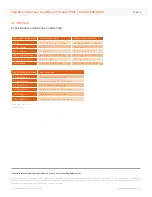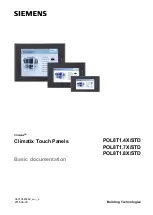
1.0 INTRODUCTION
The purpose of this guide is to provide general information regarding the proper installation and handling of SunEdison
photovoltaic modules that serve residential, commercial, and industrial segments. System design, construction, and
commissioning should be performed by qualified personnel only.
To ensure system integrity, designers, installers and operators must meet all mechanical and electrical requirements for
the system and its components. It is the responsibility of the system designer and installer to ensure that all codes and
requirements are followed as well.
Please review all the sections that pertain to proper installation of modules listed in this guide. The instructions detailed in
this guide must be followed throughout the module’s lifetime deployment. If you need additional information about the safe,
proper use and handling of SunEdison photovoltaic module products, please contact SunEdison.
2.0 PHOTOVOLTAIC MODULES PRODUCT CODE
3.0 MODULE OVERVIEW
SunEdison Silvantis Photovoltaic modules consist of a series of electrically interconnected crystalline silicon solar cells that are
sealed within a laminated sheet of tempered glass superstrate* and EVA/back-sheet substrate. These laminates are secured
inside an aluminum frame to provide rigidity and a means for attachment to mounting sub-structures. The frames should not
be modified or removed.
* Tempered glass may have AR coating.
• Photovoltaic modules are designed and constructed for outdoor use. Do not submerge modules in water at any time.
• The front and back of each module is labeled with a product bar code. Do not cover, remove or deface these labels.
This may be required for product identification.
• Damage to the glass surface or the anti-reflective coating can impact the power output and overall efficiency of the
system. Scratches, handling marks, or any damage to the glass surface must be avoided.
• For best performance and to avoid potential issues, keep the front side of the module clean and free of obstructions
including covers, tape, adhesives, paint and debris.
3.1 MAINTENANCE
Check modules, glass, and frames for damage. Regularly inspect all SunEdison solar modules for safe electrical connections,
sound mechanical connections, and freedom from shading and corrosion. If dirt or debris buildup becomes excessive,
periodically clean the glass only with a soft cloth using mild, non-abrasive detergent and water. When using mild cleaning
liquids, a neutral pH in the range of 6.0 to 8.0 is recommended. Chemicals with pH less than 6.0 or greater than 8.0 should
be avoided as it may damage the glass surface and or the AR coating. Please consult with system designer to decide the
cleaning and inspection frequency according to local environmental conditions.
Do not power wash or use harsh cleaning materials or objects such as scouring powder, steel wool, scrapers, blades, or other
sharp instruments to clean the glass surface of the module. Use of such materials will invalidate the product warranty.
WARNING: Use caution when cleaning the back surface of the module to avoid penetrating the substrate materials.
2 of 17
P280ByC
P285ByC
P290ByC
P295ByC
P300ByC
P305ByC
M310ByC
M315ByC
M320ByC
M325ByC
M3330ByC
M335ByC
F310ByC
F315ByC
F320ByC
F325ByC
F330ByC
F335ByC
D310ByC
D315ByC
D320ByC
D325ByC
D330ByC
D335ByC
Installation Manual: SunEdison Silvantis P300 | M330/F330/D330
© Copyright 2014 SunEdison, Inc.
Silvantis
TM
P300
Multicrystalline Modules
Silvantis
TM
M330
Monocrystalline Modules
Silvantis
TM
F330
Monocrystalline Modules
Silvantis
TM
D330
Monocrystalline Modules




































